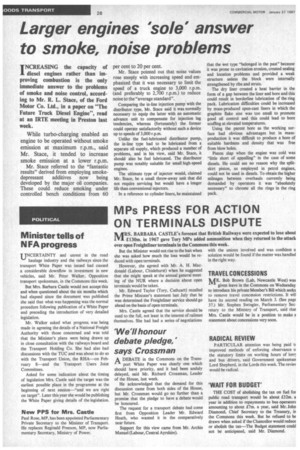Larger engines 'sole' answer to smoke, noise problems
Page 30

If you've noticed an error in this article please click here to report it so we can fix it.
I NCREASING the capacity of diesel engines rather than improving combustion is the only immediate answer to the problems of smoke and noise control, according to Mr. R. L. Stace, of the Ford Motor Co. Ltd., in a paper on "The Future Truck Diesel Engine", read at an IRTE meeting in Preston last week.
While turbo-charging enabled an engine to be operated without smoke emission at maximum r.p.m., said Mr. Stace, it tended to increase smoke emission at a lower r.p.m.
Mr. Stace referred to the "fantastic results" derived from employing smokedepressant additives now being developed by the major oil companies. These could reduce smoking under controlled bench conditions from 60 per cent to 20 per cent.
Mr. Stace pointed out that noise values rose steeply with increasing speed and emphasized that it was necessary to limit the speed of a truck engine to 3,000 r.p.m. (and preferably to 2,700 r.p.m.) to reduce noise to the "average standard".
Comparing the in line injection pump with the distributor type, Mr. Stace said it was normally necessary to equip the latter with an automatic advance unit to compensate for injection lag tendencies, whereas (fortunately) the former could operate satisfactorily without such a device up to speeds of 3,000 r.p.m.
Unlike the fuel-lubricated distributor pump, the in-line type had to be lubricated from a separate oil supply, which produced a number of problems, and in his view, said Mr. Stace, it should also be fuel lubricated. The distributor pump was notably suitable for small high-speed engines.
The ultimate type of injector would, claimed Mr. Stace, be a small throw-away unit that did not require servicing but would have a longer life than conventional injectors.
In a reference to cylinder liners, he maintained that the wet type "belonged in the past" because it was prone to cavitation erosion, created sealing and location problems and provided a weak structure unless the block were internally strengthened by ribs and struts.
The dry liner created a heat barrier in the form of a gap between the liner and bore and this could result in borderline lubrication of the ring pack. Lubrication difficulties could be increased by mass-produced spun-cast liners in which the graphite flake size was too small to promote good oil control and this could lead to bore scuffing at elevated temperatures.
Using the parent bore as the working surface had obvious advantages but in massproduction it was difficult to produce a bore of suitable hardness and density that was free from blow holes.
Piston slap when the engine was cold was "little short of appalling" in the case of some diesels. He could see no reason why the splitskirt piston, as employed in petrol engines, could not be used in diesels. To obtain the higher mileages between overhauls currently being demanded by operators it was "absolutely necessary" to chrome all the rings in the ring pack.












































































































